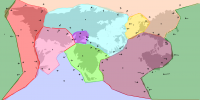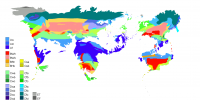Difference between revisions of "Aravala"
(→Climate) |
(→Climate) |
||
| Line 105: | Line 105: | ||
[[File:Aravala 0.4 köppen 2.png|200px|thumb|left|Köppen Climate classification of Aravala]] | [[File:Aravala 0.4 köppen 2.png|200px|thumb|left|Köppen Climate classification of Aravala]] | ||
| + | |||
| + | The climate model map of Aravala showing the [[Köppen climate classification]] regions of Aravala. The Köppen climate classification scheme divides climates into five main climate groups: ''A'' (tropical), ''B'' (dry), ''C'' (temperate), ''D'' (continental), and ''E'' (polar). The second letter indicates the seasonal precipitation type, while the third letter indicates the level of heat. Summers are defined as the 6-month period that is warmer either from April–September and/or October–March while winter is the 6-month period that is cooler. | ||
==Continents== | ==Continents== | ||
[[Category:Aravala]][[Category:Universes]] | [[Category:Aravala]][[Category:Universes]] | ||
Revision as of 06:24, 16 May 2021
 The most widely used photograph of Earth, taken by SNTL Cosmonauts in 1975 | |||||||||||||
| Designations | |||||||||||||
|---|---|---|---|---|---|---|---|---|---|---|---|---|---|
| Earth, World, Maa, Maapallo, Daellak | |||||||||||||
| Adjectives | Aravalanian | ||||||||||||
| Orbital characteristics | |||||||||||||
| Aphelion | 152,100,000 km | ||||||||||||
| Perihelion | 147,095,000 km | ||||||||||||
| 149,598,023 km | |||||||||||||
| Eccentricity | 0.0167086 | ||||||||||||
| 365.256363004 d | |||||||||||||
Average orbital speed | 29.78 km/s | ||||||||||||
| 358.617° | |||||||||||||
| Inclination | 7.155 ° to the Sun 's equator ; 1.57869 ° to invariable plane ; 0.00005° to J2000 | ||||||||||||
| -11.26064 ° to J2000 ecliptic | |||||||||||||
| 2021-Jan-02 13:59 | |||||||||||||
| 114.20783 ° | |||||||||||||
| Satellites |
| ||||||||||||
| Physical characteristics | |||||||||||||
Mean radius | 6371.0 km | ||||||||||||
Equatorial radius | 6378.137 km | ||||||||||||
Polar radius | 6356.752 km | ||||||||||||
| Flattening | 1/ 298.257222101 VMplRS93 | ||||||||||||
| Circumference |
| ||||||||||||
| |||||||||||||
| Volume | 1.08321 e=12km3 | ||||||||||||
| Mass | 5.97237 e=24kg | ||||||||||||
Mean density | 5.514 g/cm3 | ||||||||||||
| 9.80665 m/s2 | |||||||||||||
| 0.3307 | |||||||||||||
| 11.186 km/s | |||||||||||||
Sidereal rotation period | 0.99726968 d | ||||||||||||
Equatorial rotation velocity | 1674.4 km/h | ||||||||||||
| 23.4392811° | |||||||||||||
| Albedo | 0.367 Geometric albedo 0.306 Bond albedo | ||||||||||||
| |||||||||||||
| Atmosphere | |||||||||||||
Surface pressure | 101.325 kPa (at Sea level ) | ||||||||||||
| Composition by volume |
| ||||||||||||
Etymology
The name Aravala Is not used as name for the Planet, but the local inhabitants call it simply as planet earth, or Maa , Maapallo In Evoan language. Aravala Is included as a name, to separate it from the world of the viewer. The Term Aravala appear in Evoan Religious concepts as Otherworldly afterlife, where the Gods and spirits dwells, and is in some sources described to include alternate worlds, therefore is been chosen to be used as the describing and Defining term when used in our world.
Geography
Main article: Geography of Aravala, Aravala
Map of Aravala
Map of Aravala shown in Winkel-Tripel projection.
The shape of Aravala is nearly spherical. There is a small flattening at the poles and equatorial bulge around the equator due to Aravala's rotation, therefore, a better approximation of Aravala's shape is an oblate spheroid, whose equatorial diameter is 43 kilometres (27 mi) larger than the Geographical pole-to-pole diameter.
The average diameter of the reference spheroid is 12,742 kilometres (7,918 mi). Local topography deviates from this idealized spheroid, although on a global scale these deviations are small compared to Aravala's radius: the maximum deviation of only 0.17% is at the Oipaal Trench (10,945 metres or 35,909 feet below local sea level), In geodesy, the exact shape that Aravala's oceans would adopt in the absence of land and perturbations such as tides and winds is called the geoid. More precisely, the geoid is the surface of gravitational equipotential at mean sea level are water deviations from MSL, analogous to land topography.
Plate tectonics
The Aravala's litosphere is divided into 11 major tectonic plates, which movements and directions are visualized in this simplified graph.
Climate
The climate model map of Aravala showing the Köppen climate classification regions of Aravala. The Köppen climate classification scheme divides climates into five main climate groups: A (tropical), B (dry), C (temperate), D (continental), and E (polar). The second letter indicates the seasonal precipitation type, while the third letter indicates the level of heat. Summers are defined as the 6-month period that is warmer either from April–September and/or October–March while winter is the 6-month period that is cooler.


